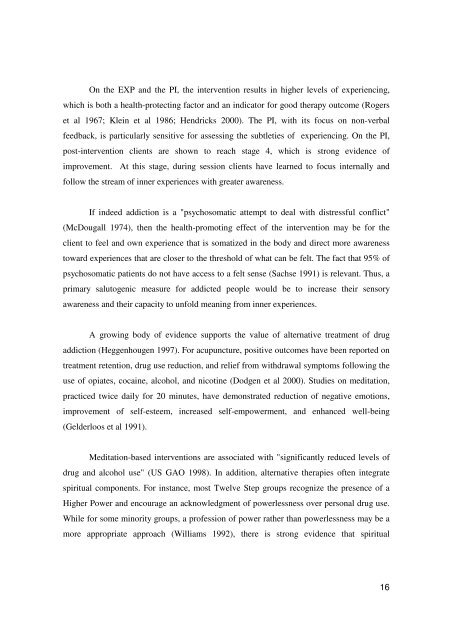article - Process Work, Reini Hauser
article - Process Work, Reini Hauser
article - Process Work, Reini Hauser
You also want an ePaper? Increase the reach of your titles
YUMPU automatically turns print PDFs into web optimized ePapers that Google loves.
On the EXP and the PI, the intervention results in higher levels of experiencing,<br />
which is both a health-protecting factor and an indicator for good therapy outcome (Rogers<br />
et al 1967; Klein et al 1986; Hendricks 2000). The PI, with its focus on non-verbal<br />
feedback, is particularly sensitive for assessing the subtleties of experiencing. On the PI,<br />
post-intervention clients are shown to reach stage 4, which is strong evidence of<br />
improvement. At this stage, during session clients have learned to focus internally and<br />
follow the stream of inner experiences with greater awareness.<br />
If indeed addiction is a "psychosomatic attempt to deal with distressful conflict"<br />
(McDougall 1974), then the health-promoting effect of the intervention may be for the<br />
client to feel and own experience that is somatized in the body and direct more awareness<br />
toward experiences that are closer to the threshold of what can be felt. The fact that 95% of<br />
psychosomatic patients do not have access to a felt sense (Sachse 1991) is relevant. Thus, a<br />
primary salutogenic measure for addicted people would be to increase their sensory<br />
awareness and their capacity to unfold meaning from inner experiences.<br />
A growing body of evidence supports the value of alternative treatment of drug<br />
addiction (Heggenhougen 1997). For acupuncture, positive outcomes have been reported on<br />
treatment retention, drug use reduction, and relief from withdrawal symptoms following the<br />
use of opiates, cocaine, alcohol, and nicotine (Dodgen et al 2000). Studies on meditation,<br />
practiced twice daily for 20 minutes, have demonstrated reduction of negative emotions,<br />
improvement of self-esteem, increased self-empowerment, and enhanced well-being<br />
(Gelderloos et al 1991).<br />
Meditation-based interventions are associated with "significantly reduced levels of<br />
drug and alcohol use" (US GAO 1998). In addition, alternative therapies often integrate<br />
spiritual components. For instance, most Twelve Step groups recognize the presence of a<br />
Higher Power and encourage an acknowledgment of powerlessness over personal drug use.<br />
While for some minority groups, a profession of power rather than powerlessness may be a<br />
more appropriate approach (Williams 1992), there is strong evidence that spiritual<br />
16


